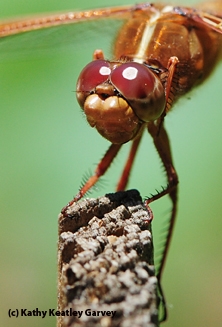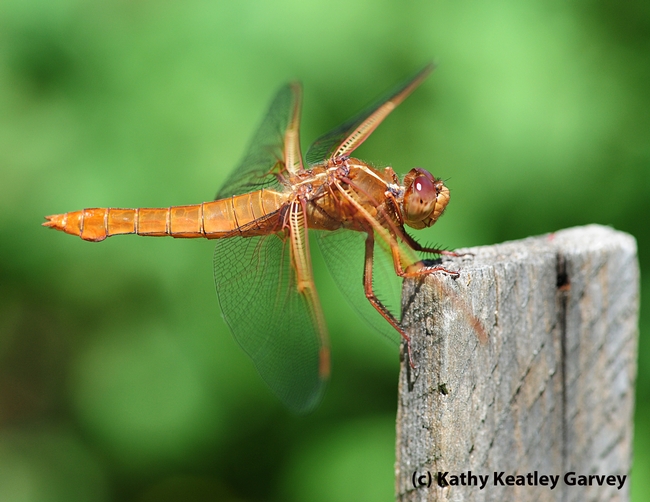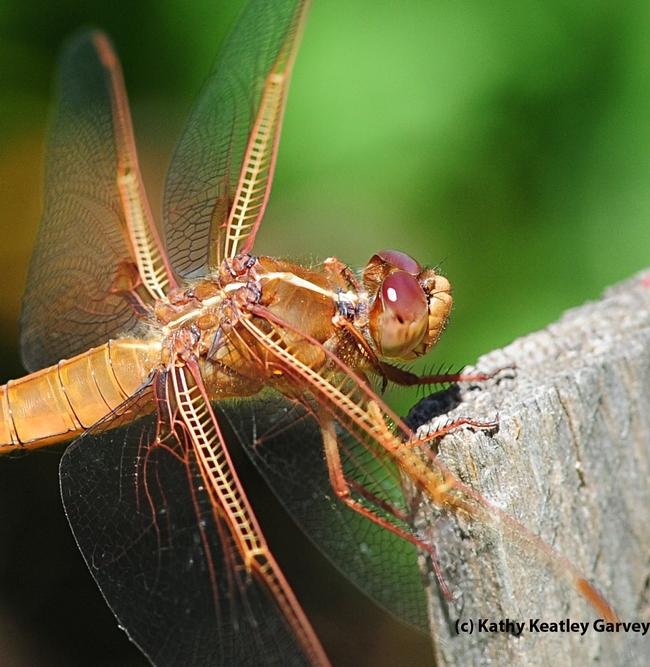
It's a joy to watch these firecracker-red dragonflies (Libellula saturata) make their presence known. They dart over our fish pond, snatch an insect, and then perch on a tomato-plant stake to eat it.
Last year another generation did the same thing. They darted over our fish pond, snatched an insect, and then staked their claim in the vegetable garden. Over a tomato plant.
Most of the time the flame skimmers seem unaware of my presence. Guess they consider me neither prey nor predator.
If you love dragonflies, several years ago the Bohart Museum of Entomology, University of California, Davis, created an educational poster, "Dragonflies of California," the work of doctoral candidate Fran Keller and naturalist/photographer Greg Kareofelas of Davis. It focuses on 18 dragonflies commonly found in the Golden State. The largest insect depicted in the poster is the Giant Darner (Anax walshinghami), but the most colorful just has to be...drum roll...the flame skimmer. But I'm biased.
Keller came up with these facts about dragonflies:
Ten fast facts about dragonflies, as provided by the Bohart Museum:
- Dragonflies date back before the dinosaur age.
- The largest known prehistoric species of dragonfly, living 300 million years ago, was the Meganeura monyi. Its wingspan measured more than two feet long.
- The largest species today is a South American dragonfly with a wingspan of 7.5 inches. The smallest modern species is an east Asian dragonfly, the libellulid dragonfly, Nannophya pygmaea, with a wingspan of about 3/4 of an inch.
- California is home to approximately 108 species. More than 5000 species are found worldwide.
- Dragonflies help control pests such as mosquitoes, midges and flies, but will also dine on honey bees and butterflies.
- The adults feed by hawking their prey. They dart off a perch to catch prey and often return to the perch to eat.
- Most dragonflies live around lakes, ponds, streams, and marshes; their larvae, known as “nymphs,” are aquatic. Some dragonfly larvae live in bromeliad flowers.
- Dragonflies usually do not bite or sting humans, but if grasped by the abdomen, they may bite to escape.
- The dragonfly is thought to have better eyesight than any other insect. Its compound eyes take up much of the insect’s head. Each compound eye has up to 30,000 facets or sensor modules, arranged to provide nearly a 360-degree field of vision. That's why it's difficult to sneak up on them.
- Dragonflies are a common motif in Native American art, displayed on Zuni pottery, Hopi rock art and on Pueblo necklaces. In Japan, they are considered symbols of courage, strength and happiness.
The Bohart Museum, home of more than seven million insects, is open year around, but is closed to the public on Friday. It's directed by Lynn Kimsey, professor of entomology att UC Davis.
But if you want to see dragonflies in The Great Outdoors, look for them near a body of water, whether it be a river, creek or...a fish pond in the back yard...
Attached Images:

